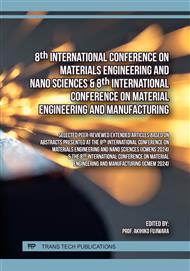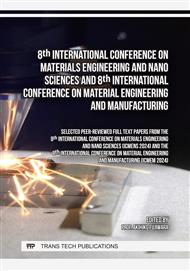p.13
p.19
p.25
p.31
p.37
p.45
p.53
p.59
p.65
Particle Characteristics of Diatomite Activated by Alkaline Solution
Abstract:
In this study, the activation of natural diatomite was done with alkaline solution. The diatomite powder was sieved and purified prior to activation at room temperature (Alk-DA RT) and 85 °C (Alk-DA 85 °C). The effect of activation time of Alk-DA 85 °C samples was observed for 1 h, 2 h and 5 h. At temperature interval from room temperature to 530 °C, the weight loss for all of Alk-DA are less than R-DA. The reduction of particle aggregation was found in Alk-DA at both RT and 85 °C as shown in SEM images, indicating the activation by NaOH that effectively breaks down the bulky structure. The formation of silanol group (Si-OH) were obtained on the surface of Alk-DA. However, BET result revealed there is no increment of surface area and porosity in case of RT. In addition, Alk-DA 85 °C samples at 1 h and 2 h provided the spongy surfaces with obvious improvement of surface area, and reduction in porosity and pore size. In contrast, Alk-DA 85 °C 5 h showed more cluster of particle aggregation. Moreover, it can be observed that Alk-DA 85 °C 1 h is the most interesting for further study since it potentially provides high gas adsorption but only requires a shorter activation time.
Info:
Periodical:
Pages:
37-43
Citation:
Online since:
September 2024
Authors:
Keywords:
Price:
Сopyright:
© 2024 Trans Tech Publications Ltd. All Rights Reserved
Share:
Citation:



